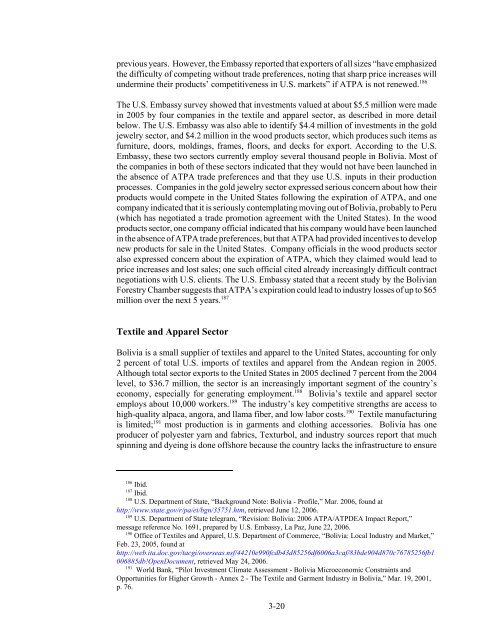The Impact of the Andean Trade Preference Act Twelfth ... - USITC
The Impact of the Andean Trade Preference Act Twelfth ... - USITC
The Impact of the Andean Trade Preference Act Twelfth ... - USITC
- No tags were found...
You also want an ePaper? Increase the reach of your titles
YUMPU automatically turns print PDFs into web optimized ePapers that Google loves.
previous years. However, <strong>the</strong> Embassy reported that exporters <strong>of</strong> all sizes “have emphasized<strong>the</strong> difficulty <strong>of</strong> competing without trade preferences, noting that sharp price increases willundermine <strong>the</strong>ir products’ competitiveness in U.S. markets” if ATPA is not renewed. 186<strong>The</strong> U.S. Embassy survey showed that investments valued at about $5.5 million were madein 2005 by four companies in <strong>the</strong> textile and apparel sector, as described in more detailbelow. <strong>The</strong> U.S. Embassy was also able to identify $4.4 million <strong>of</strong> investments in <strong>the</strong> goldjewelry sector, and $4.2 million in <strong>the</strong> wood products sector, which produces such items asfurniture, doors, moldings, frames, floors, and decks for export. According to <strong>the</strong> U.S.Embassy, <strong>the</strong>se two sectors currently employ several thousand people in Bolivia. Most <strong>of</strong><strong>the</strong> companies in both <strong>of</strong> <strong>the</strong>se sectors indicated that <strong>the</strong>y would not have been launched in<strong>the</strong> absence <strong>of</strong> ATPA trade preferences and that <strong>the</strong>y use U.S. inputs in <strong>the</strong>ir productionprocesses. Companies in <strong>the</strong> gold jewelry sector expressed serious concern about how <strong>the</strong>irproducts would compete in <strong>the</strong> United States following <strong>the</strong> expiration <strong>of</strong> ATPA, and onecompany indicated that it is seriously contemplating moving out <strong>of</strong> Bolivia, probably to Peru(which has negotiated a trade promotion agreement with <strong>the</strong> United States). In <strong>the</strong> woodproducts sector, one company <strong>of</strong>ficial indicated that his company would have been launchedin <strong>the</strong> absence <strong>of</strong> ATPA trade preferences, but that ATPA had provided incentives to developnew products for sale in <strong>the</strong> United States. Company <strong>of</strong>ficials in <strong>the</strong> wood products sectoralso expressed concern about <strong>the</strong> expiration <strong>of</strong> ATPA, which <strong>the</strong>y claimed would lead toprice increases and lost sales; one such <strong>of</strong>ficial cited already increasingly difficult contractnegotiations with U.S. clients. <strong>The</strong> U.S. Embassy stated that a recent study by <strong>the</strong> BolivianForestry Chamber suggests that ATPA’s expiration could lead to industry losses <strong>of</strong> up to $65million over <strong>the</strong> next 5 years. 187Textile and Apparel SectorBolivia is a small supplier <strong>of</strong> textiles and apparel to <strong>the</strong> United States, accounting for only2 percent <strong>of</strong> total U.S. imports <strong>of</strong> textiles and apparel from <strong>the</strong> <strong>Andean</strong> region in 2005.Although total sector exports to <strong>the</strong> United States in 2005 declined 7 percent from <strong>the</strong> 2004level, to $36.7 million, <strong>the</strong> sector is an increasingly important segment <strong>of</strong> <strong>the</strong> country’seconomy, especially for generating employment. 188 Bolivia’s textile and apparel sectoremploys about 10,000 workers. 189 <strong>The</strong> industry’s key competitive strengths are access tohigh-quality alpaca, angora, and llama fiber, and low labor costs. 190 Textile manufacturingis limited; 191 most production is in garments and clothing accessories. Bolivia has oneproducer <strong>of</strong> polyester yarn and fabrics, Texturbol, and industry sources report that muchspinning and dyeing is done <strong>of</strong>fshore because <strong>the</strong> country lacks <strong>the</strong> infrastructure to ensure186Ibid.187Ibid.188U.S. Department <strong>of</strong> State, “Background Note: Bolivia - Pr<strong>of</strong>ile,” Mar. 2006, found athttp://www.state.gov/r/pa/ei/bgn/35751.htm, retrieved June 12, 2006.189 U.S. Department <strong>of</strong> State telegram, “Revision: Bolivia: 2006 ATPA/ATPDEA <strong>Impact</strong> Report,”message reference No. 1691, prepared by U.S. Embassy, La Paz, June 22, 2006.190Office <strong>of</strong> Textiles and Apparel, U.S. Department <strong>of</strong> Commerce, “Bolivia: Local Industry and Market,”Feb. 23, 2005, found athttp://web.ita.doc.gov/tacgi/overseas.nsf/44210e990fcdb43d85256df6006a3caf/83bde904d870c76785256fb1006885db!OpenDocument, retrieved May 24, 2006.191World Bank, “Pilot Investment Climate Assessment - Bolivia Microeconomic Constraints andOpportunities for Higher Growth - Annex 2 - <strong>The</strong> Textile and Garment Industry in Bolivia,” Mar. 19, 2001,p. 76.3-20
















